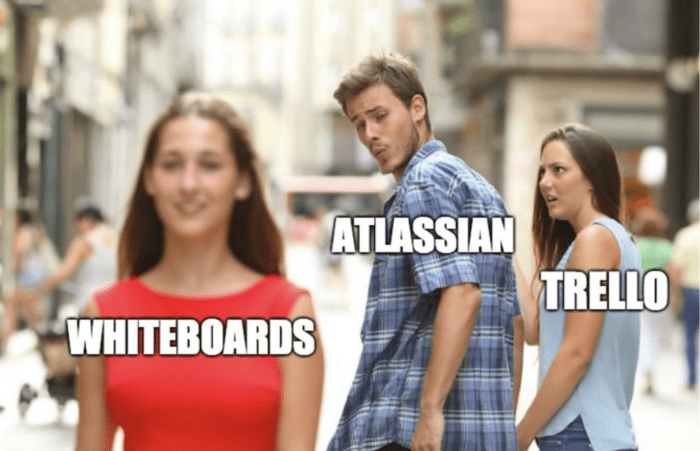Should you use Trello as an agile retrospective tool?
The majority of teams running agile retrospectives today run them on whiteboards. We’ve already explored why whiteboard and sticky notes agile retros are suboptimal if you value your team’s discussion quality, accountability, and engagement. What about the other teams? What do they use to run their agile retrospectives?
It’s usually Trello. Founded in 2011, Trello has been the visual way for teams to collaborate on any project. You can see information at a glance, get seamless collaboration, and are always in sync with your team. Plus, you can use Power-Ups from your favorite tools to turn your Trello board into a living application. It can be everything for everyone. The project management jack of all trades, master of none. This is especially true for agile retrospectives. So much so that Atlassian, the mothership company behind Trello, suggests that instead of Trello, you should use a whiteboard and sticky notes to run your agile retrospectives.
1. The Basics 📝
When you consider what teams want from their agile retrospectives and compare that with what’s available in Trello, it’s hard to notice why you wouldn’t want to use it. It’s superior to the free digital whiteboard and sticky note solutions:
2. The Power-Ups Trap 🌋
But once you go beyond the basics, everything needs to be customized via Power-Ups. Voting. Anonymity. Due dates. Slack integration. And you’d have to do this every time you create a board. We’re not talking aspirational features here — these are basic necessities!
In other words, if you want to run a professional-grade agile retrospective, get ready to add a lot of Power-Ups.
What’s so wrong about Power-Ups? Just like Slack, these integrations are one of Trello’s greatest strengths. But unless you are on their $9.99/user/month business plan or $20.83/user/month enterprise plan, you and your team are limited to 1 Power-Up per board. Additionally, as agile retrospectives often touch upon confidential and sensitive topics, security is a huge concern! Increasingly requested security features such as 2-factor authentication or file encryption at rest for your team are not available unless you are on the most expensive tier, the $20.83/user/month enterprise plan. That’s a steep price to pay for what most teams consider table stakes security features.
3. The Have-Nots 💨
Once we start looking below the surface of Trello, you’ll notice many features it doesn’t support for agile retrospectives (even via Power-Up):
It’s going to be difficult to have balanced and timely discussions without those. We empathize with the Scrum Master or PM who will be tasked with managing the action item and follow-ups that come out of those agile retrospectives. It often ends up being a goose chase trying to identify owners and statuses. Further to that, teams get no trends or analytics over the course of the project to optimize process and behaviour going forward.
Now don’t get me wrong. I think Trello is a fantastic tool for collaboration and project management. Heck, we even use it from time to time. But if we evaluate Trello as a tool for agile retros, the facts are clear. Even Atlassian recognizes that it is not an agile retrospective tool.
Do you use Trello for your agile retros? Let us know and we can help you get started with a tool built specifically for agile retrospectives in Sprintlio.



